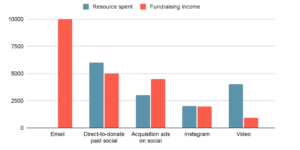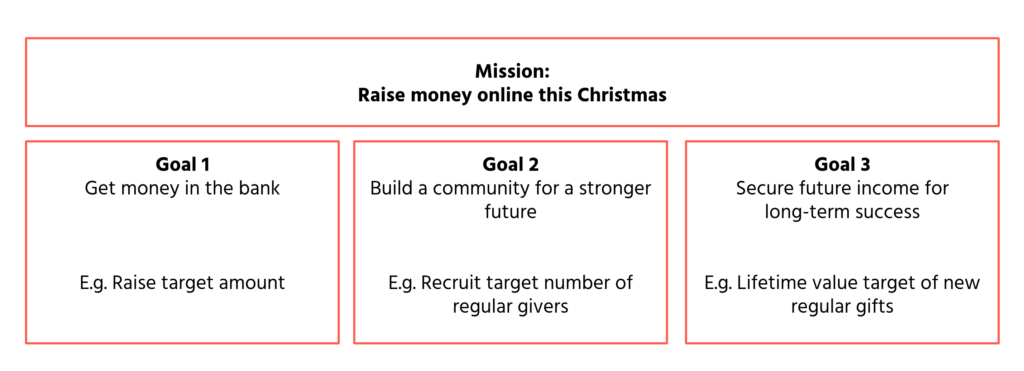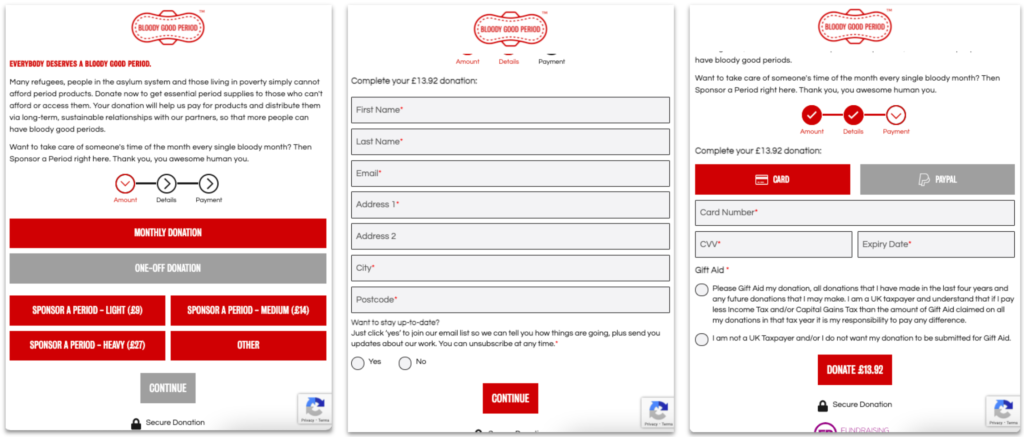In our September webinar, Forward Action’s digital strategy manager, John Braid, and partnerships director, Ali Walker Davies, talked through our top tips to maximise your Christmas fundraising.
Whether you’ve run years of festive campaigns or this is your first seasonal fundraising push, this blog covering key points from the session should help you make Christmas 2021 a roaring success.
Firstly, why invest in Christmas fundraising?
The festive season presents a huge fundraising moment for charities. Data from CAF Giving in 2020 shows that 40% of people donated to charity in the run-up to Christmas, and the mean average donation (including through sponsorship) peaked at £61.
So, more people give to charity at Christmas and they’re more generous too. The trend of making charity donations at this time of year is also supported by the growth of high profile initiatives like Giving Tuesday and The Big Give.
But at the same time, with more charities competing for people’s attention, the cost of advertising increases. So it can be harder to get cut-through, especially if your organisation is new to festive fundraising, or your work doesn’t have an obvious connection to winter or Christmas.
To help maximise your seasonal fundraising income, here’s five key actions to take today:
- Start with your data
- Plan ahead
- Test your way to success
- Focus your energy where it matters
- Keep the conversation going
- (Bonus!) Q&A: Your questions answered from our September Webinar
1. Start with your data
Your Christmas fundraising strategy should ideally be built on learning from previous years. So take a good look at your data: what’s worked for you before and what hasn’t?
Review the digital channels you’ve used in the past, and compare money or time spent with income gained. That might look something like this:

Once you’ve calculated the return on investment (ROI) for each channel, you can decide which ones to put most time and budget behind this year.
If you don’t have robust data for previous years or you’re new to raising money online, we recommend prioritising Facebook ads to recruit new supporters and email to fundraise.
Paid search is also worth looking at. This tends to be an underused channel in the charity sector, but the latest M+R Benchmarks Study shows it can offer the best ROI.
Crucially, make sure you’ve got good systems in place to record this year’s data. Think about time and money spent, and key performance metrics for each channel you use.
2. Plan ahead
If you carve out time to plan for your Christmas fundraising push well in advance, you’ll reap huge rewards. Start with your key goals. Get your team to agree on one overarching ambition, and then break it down into smaller subgoals, each with a specific target. For example:

Once your goals and targets are agreed, they’ll form the basis for your strategy and help you decide which activities to prioritise. Focus your energy on achieving them, ruthlessly!
Next, you need to plan how to meet these goals.
For your fundraising emails, you can easily plan a schedule using key dates already in your calendar. These could be things like:
- Holiday dates – 10 days til Christmas, Christmas Eve, New Year’s Eve, back to work
- Awareness days – Giving Tuesday, World AIDS Day, Human Rights Day
- Organisational milestones – a key anniversary, a campaign win or update.
You’ll also want to allow calendar space and team capacity for reactive communications in case stories come up in the news that would make good email hooks. You’ll find more ideas and tips on our blog about setting up Greenpeace’s fundraising email programme.
And finally, don’t forget to thank people at the end of the campaign. This isn’t only good relationship-building: sending a wrap-up email emphasising the impact of supporters’ generosity – with a ‘last chance to donate’ link – can encourage people who haven’t yet given to chip in too.
3. Test your way to success
Testing is the only way to optimise your supporter journeys and make sure you don’t miss out on vital donation income.
And it can make a massive difference: one test we ran on the images used in Facebook ads cut the cost per lead by 43%. Gains like this mean you can recruit more people with the same budget, which has a significant impact on donation income further down the funnel.
So, build in testing at every stage of your user journey. That could include Facebook ads, sign-up pages, emails, donation forms and thank you pages.
Top tips for testing:
- Try to test things that are very different, such as framing an issue in different ways, or using contrasting images.
- Always test your opt-in language, as this can deliver significant improvements to help maximise the size of your email list.
- Use the resources you already have, such as in-platform testing tools and free software like Google Optimize.
- If you’re new to testing, keep it simple. Aim for straightforward tests that will deliver big benefits.
And remember, you can’t always rely on instinct to know what will work best. We’re often surprised by the results our tests produce, which is why running them is so important.
4. Focus your energy where it matters
You only have limited time to prepare and to run your campaign, so decide on a few key areas and invest your resources accordingly.
One important thing to prioritise is your donation page. If this isn’t optimised, then a lot of your other efforts will be wasted. The UK M+R Benchmarks Study gives an average donation page conversion rate for charities of just 16%, so there’s huge potential for improvement. If you’re not sure where to start, we’ve gathered a whole blog of donation page optimisations for you to try.
We’ve found that clean and simple donation forms, broken into three stages, work well.

If you don’t have time to revamp your page, you can still improve the UX by doing things like:
- reducing the amount of text or images
- shortening the form by removing non-mandatory fields
- pre-selecting the donation amount for people clicking through from email
- moving administrative copy (eg, the privacy policy) to below the donate button.
Before you put time, effort and energy into any new fundraising or supporter recruitment tactics, try using the ‘MVP’ approach (minimum viable product). This means building out your idea in the quickest, lowest budget way you can, to trial it and see how it performs before deciding whether to invest in it further. For example, if you want to trial using Facebook Ads – test a range of approaches with small budgets to see if ads could be a promising approach for your organisation before investing further.
5. Keep the conversation going
Once a supporter has taken one action in support, they are far more likely to take another, so it’s well worth keeping the conversation going.
Be prepared to send more frequent emails than you would at other times of the year to make sure your message is seen amidst the noise. Mix them up so they’re not all direct donation asks, but don’t be afraid to ask for money a number of times – people expect this at Christmas and it doesn’t tend to affect unsubscribe rates.
If you don’t have time to write a lot of new emails, don’t worry. You can also:
- send a couple of ‘kickers’ – forward the last message you sent, with a few lines of copy asking if the supporter saw it and explaining why you didn’t want them to miss it.
- send some short, snappy emails – there’s no need to tell the whole story every time, sometimes quick reminders that you’re raising money for Christmas can work well.
Send each email to the broadest audience you can, and if you need to segment or personalise, keep it simple. That could just mean inserting an extra line of copy to acknowledge people who have previously donated.
Last, but definitely not least, we were asked lots of brilliant questions during the September webinar. Unfortunately there wasn’t time to answer them all, so here is a quick set of answers for some of the questions asked.
Q&A
Q. What should an organisation do if it has no benchmarks from previous years?
The M+R benchmarks Study, which offers a comprehensive look at the sector, is a great place to start. If this is your first year of Christmas fundraising, it’s all about proof of concept with a view to greater investment in future years. Let senior management know this, and make sure you get a good spreadsheet and systems in place to document performance.
Q. How should tests be timed over the Christmas period, and how long do they need to run for?
It depends on the test and the volume of traffic. Facebook ads tests can often give clear results in a few days, whereas on-page tests often need to run for quite a long time. So don’t try and squeeze too many in. Brainstorm ideas for tests, and then prioritise them in terms of ease to run and potential impact. For each part of your supporter journey (eg, Facebook ads, email, donate page), only test one thing at a time, otherwise it won’t be clear which change has produced the results you’re seeing. But you can run tests on different parts of the journey at the same time.
Q. Is there an optimal time gap between sending an initial email and following it with a kicker?
This varies. We’d recommend drafting and building the kicker at the same time as you create the initial email. It can usually just be a short paragraph or two above your original email, essentially saying, ‘did you miss this?’ You can then monitor the performance of the first email and send the kicker once engagement starts to tail off (usually around 1-2 days later).
Q. What’s the best way to show the impact of a Christmas campaign – is it purely about the amount raised, or should we talk about how it’s being spent too?
It’s a bit of both. Showing the amount raised and how many people have contributed is important as it can act as social proof to encourage other people to donate. If you can say exactly where the money is going too, that’s great. But the key thing is that you talk about your overall mission and explain how people’s donations will help achieve it.
Q. How do you decide when to add an extra ask to a thank you page?
If someone has just made a one-off donation, we’d always recommend including a monthly gift upsell on your thank you page. The focus should still be very much on thanking people, but adding a clear, well structured upsell can result in 3.5–5% of one-off donors setting up a regular donation. People are at their most engaged with your cause when they take an action, so it makes sense to follow it with another opportunity to help.
We hope this post has given you new ideas and approaches to support your Christmas fundraising. If you still have questions, or if you’d like support to develop your digital fundraising, we’re always happy to chat.
Our webinars take place every other month and cover a different topic within digital fundraising, campaigning and mobilisation each time. Follow us on Twitter to hear about our next one.

